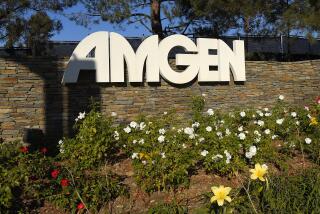Common Cause : Allergan Joint Venture Aims at Cancer Cure
- Share via
IRVINE — Drip, drip, drip. The solution slowly fills the thin test tube under the watchful eye of Diana Colon, who sits placidly amid a jumble of laboratory equipment at Allergan Inc.
The crystal-clear chemical, to be used in one of the company’s dermatology products, is the result of months of work and is the latest of 400 synthetic “retinoids” to be distilled in the Irvine lab.
“It’s very exciting,” said Colon, a 26-year-old chemist with a master’s degree from UC Irvine. “It’s a really nice feeling to know you contributed” to medical science.
More exciting for Colon and other Allergan researchers is the prospect that the company is now launching research and development that may eventually result in the use of retinoids to help cure cancer as well as a host of skin and eye ailments.
Under a joint venture announced Wednesday, Allergan said, it will use the research of a San Diego start-up cellular research concern to discover new uses for retinoids, compounds that are derivatives of vitamin A and can reverse malformation of cells.
Malformed cells are the basis for such dermatological ailments as psoriasis and acne, as well as deadly diseases such as cancer.
“The focus of the joint venture is to develop retinoids beyond the field of dermatology”--Allergan’s specialty--said Rosh Chandraratna, the company’s senior research investigator. “It’s a new era of understanding how these drugs work and . . . the different applications.”
Allergan spokesman Shel Holtz said that the company has agreed to invest $15 million in the joint venture with Ligand Pharmaceuticals, which specializes in cellular research. Ligand, a private company, will also put up $15 million.
In addition, Holtz said, Allergan will buy a 15% stake in Ligand for $20 million in cash. Allergan, Holtz said, which had 1991 revenue of $839 million, is “cash rich,” with $310 million on hand at the end of the first quarter.
The $35-million investment in the joint venture will not dilute earnings, Holtz said, because it is being taken out of the company’s budgeted research and development fund.
“This is a real significant thing for us,” Holtz said. “It will speed up the ability to discover new areas for use of retinoids.”
Working with Ligand, which specializes in research on intercellular receptors--which play a key role in regulating biological disease-affecting processes--could put both companies years ahead in developing a compound that can reverse the growth of cancerous cells without disturbing surrounding tissue.
Ligand has identified 35 intercellular receptors. Synthetic retinoids could be developed to work on specific receptors and regulate cell growth, Holtz said.
Any success is years away, company officials said. But retinoids could be useful, Chandraratna said, in treatment not only of cancer and skin disorders, but also of detached retinas.
Under the joint venture agreement, Ligand will have principal responsibility for marketing cancer-fighting products in North America. Allergan will have worldwide responsibility for distributing dermatology and ophthalmology products, as well as for marketing cancer-fighting products worldwide, Holtz said.
In Wednesday’s trading on the New York Stock Exchange, Allergan’s stock closed at $22 a share, unchanged.




